What are the real-life applications of EEG technology?
Discover how EEG's real-world applications are revolutionizing neuroscience and paving the way for new discoveries from clinical diagnostics to cognitive enhancement.

In the exciting world of neuroscience, researchers are on a mission to unravel the mysteries of the human brain. Electroencephalography (EEG) is an excellent tool, offering researchers an inside look into the intricate performance of electrical signals within the brain. In this exploration, we dive into the practical applications of EEG, shining a light on its importance and promising potential for researchers in the field.
What is an EEG Signal?
An EEG (Electroencephalogram) signal is a recording of the electrical activity generated by the neurons (nerve cells) in the brain. Neurons communicate with each other through electrical impulses, and these electrical signals can be detected and measured using electrodes placed on the scalp. The EEG signal reflects the synchronized activity of a large number of neurons firing in the brain.
The EEG signal is typically composed of different frequency components, known as brainwaves, which are classified into several bands:
- Delta (0.5-4 Hz): Associated with deep sleep and certain pathological conditions.
- Theta (4-8 Hz): Predominant in drowsiness and light sleep.
- Alpha (8-13 Hz): Dominant in relaxed wakefulness, often seen with closed eyes.
- Beta (13-30 Hz): Associated with active, alert, and focused mental states.
- Gamma (30-40 Hz and above): Linked to higher cognitive functions, perception, and consciousness.
Monitoring and analyzing EEG signals provide valuable insights into brain function, cognitive states, and can aid in diagnosing neurological disorders, studying sleep patterns, and exploring various aspects of brain activity. EEG technology is widely used in clinical settings, research laboratories, and emerging applications such as brain-computer interfaces.
Next, let's dive into the real-world applications of EEG.
Clinical Diagnostics: EEG's Role in Unraveling Brain Patterns
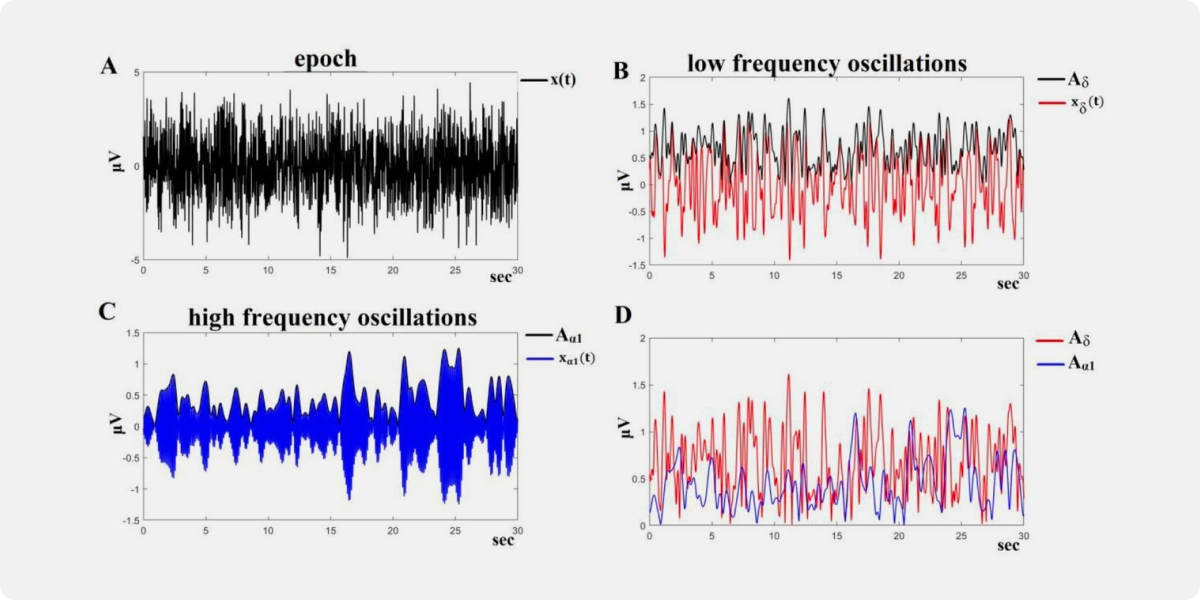
Epilepsy Monitoring: Precision in Seizure Identification
EEG technology, equipped with strategically placed electrodes on the scalp, proves indispensable in capturing and identifying abnormal electrical patterns indicative of seizures. Its role extends beyond observation, becoming a crucial tool in determining optimal strategies for treating epilepsy.
Sleep Disorders: Polysomnography's Contribution to Diagnosis
Polysomnography, a comprehensive sleep study incorporating EEG, serves as a meticulous observer of brain activity during different sleep stages. Beyond observation, EEG takes a leading role in conducting a detailed analysis essential for diagnosing a spectrum of sleep disorders, from sleep apnea to insomnia.
Neurological Research: Navigating Cognitive Processes
Cognitive Neuroscience: ERPs and Temporal Precision
In cognitive neuroscience, EEG is an active participant, measuring Event-Related Potentials (ERPs) with exceptional temporal precision. The P300 waveform, reflecting attention and memory processing, empowers researchers to investigate cognitive phenomena with unparalleled detail.
Motor Control Studies for Neuroplasticity
Within motor control studies, EEG is instrumental in decoding the brain's role in planned or imagined movements. By capturing brain activity during motor imagery tasks, researchers gain insights into neuroplasticity, laying the groundwork for advancements in prosthetics and rehabilitation technologies.
Understanding Brainwave Frequencies to Optimise Performance via Cognitive Enhancement
Techniques like entrainment and binaural beats offer insights into the frequencies governing focus and learning. Unveiling the manipulation potential within these frequencies provides researchers with valuable insights that may shape interventions for cognitive improvement. This knowledge has the power to redefine methods in cognitive research, echoing the rhythm of the brainwave symphony.
Brain-Computer Interfaces (BCIs): Enabling Mind-Machine Interaction
Assistive Technology: Interpreting Motor Imagery Commands
EEG-based BCIs serve as a vital link between the mind and external devices. By detecting motor imagery or evoked potentials associated with specific commands, individuals with severe motor impairments gain the ability to control external devices. Signal processing algorithms play a crucial role in interpreting EEG data, translating mental intentions into actionable commands.
Neurofeedback and Cognitive Enhancement
Neurofeedback Therapy: Real-Time Modulation
In the therapeutic realm, EEG becomes a tool for real-time modulation of brain activity in neurofeedback therapy. EEG's real-time monitoring helps study how individuals consciously control their brain activity. Identifying specific frequency bands, like elevated theta power and nuanced alpha activity in ADHD, opens doors for targeted interventions. This could reshape how researchers approach conditions like anxiety, ADHD, and insomnia, creating tailored solutions for complex neuro challenges.
Cognitive Enhancement: Leveraging Brainwave Frequencies
Techniques like entrainment leverage EEG data to synchronize auditory or visual stimuli with specific brainwave frequencies. This unveils the manipulation potential within these frequencies, providing profound insights for researchers and practitioners. The aim is to enhance cognitive functions by entraining brainwave patterns associated with optimal performance.
Mental Health Diagnosis and Treatment: Mapping Brain Activity
Psychiatric Disorders: qEEG Analysis for Biomarker Identification
Quantitative EEG (qEEG) analysis introduces a new dimension to mapping brain activity in specific regions. This detailed mapping allows for the identification of aberrant patterns associated with psychiatric disorders. Increased theta or delta power serves as biomarkers, aiding in diagnoses and monitoring treatment efficacy.
Treatment Monitoring: Tracking Progress in Psychiatric Interventions
In psychiatric interventions, EEG frequency band analysis becomes a trusted companion for researchers. Changes in specific frequency bands, meticulously tracked over time, serve as compass points. These indicators offer valuable insights into treatment responses and the progression of psychiatric disorders, fostering a deeper understanding for effective treatment strategies.
Sleep Research: A look into Sleep Disorders
Monitoring delta and theta waves through EEG is crucial for advancing our understanding of sleep disorders. Researchers use EEG markers to explore sleep quality, diagnose disorders, and understand the connections between sleep and mental well-being. Specific EEG patterns correlate with conditions like borderline personality disorder, Rett syndrome, Asperger syndrome, respiratory failure, chronic fatigue, PTSD, and insomnia, opening rich avenues for exploration in sleep studies.
Integrating EEG with Advanced Technologies
The fusion of EEG with advanced technologies, especially artificial intelligence (AI), opens new frontiers for researchers. Applying machine learning algorithms to extensive EEG datasets has the potential to reveal intricate patterns and correlations, creating a symphony of synergy. This collaboration significantly amplifies the precision of diagnoses and treatment plans, propelling neuroscientific research into an era of profound discovery.
As researchers explore EEG applications, ethical considerations take centre stage. Privacy concerns, data security, and responsible handling of neurological information become critical. Researchers, much like skilled navigators, must traverse these ethical waters with discernment, ensuring the judicious and ethical use of EEG technologies in their studies.
In Conclusion
Electroencephalography (EEG) stands as an indispensable tool for researchers in neuroscience. Its applications span from delicate explorations into brain activity regulation to cognitive enhancement, sleep research, mental health diagnostics, and the integration with advanced technologies. As researchers continue to unravel the tapestry of the brain, EEG remains a resounding instrument, opening new avenues in our search for a deeper, more profound understanding of the mind.
Resources & further reading:
NCBI - WWW Error Blocked Diagnostic
NCBI - WWW Error Blocked Diagnostic
EEG Frequency Bands in Psychiatric Disorders: A Review of Resting State Studies
https://www.sciencedirect.com/science/article/pii/S0010482523001415
https://www.sciencedirect.com/science/article/pii/S0035378721006974
(PDF) Influence of Binaural Beats on EEG Signal
https://www.sciencedirect.com/science/article/pii/S1878929323001172
NCBI - WWW Error Blocked Diagnostic
Sleep Quality and Electroencephalogram Delta Power
Sleep EEG for Diagnosis and Research | Bitbrain
(PDF) Sleep Quality and Electroencephalogram Delta Power
NCBI - WWW Error Blocked Diagnostic
https://link.springer.com/article/10.1007/s10489-023-04702-5
EEG Frequency Bands in Psychiatric Disorders: A Review of Resting State Studies
Potential diagnostic biomarkers for schizophrenia

Capturing a biosignal is only the beginning. The real challenge starts once those tiny electrical fluctuations from your brain, heart, or muscles are recorded. What do they mean? How do we clean, interpret, and translate them into something both the machine and eventually we can understand? In this blog, we move beyond sensors to the invisible layer of algorithms and analysis that turns raw biosignal data into insight. From filtering and feature extraction to machine learning and real-time interpretation, this is how your body’s electrical language becomes readable.
Every heartbeat, every blink, every neural spark produces a complex trace of electrical or mechanical activity. These traces known collectively as biosignals are the raw currency of human-body intelligence. But in their raw form they’re noisy, dynamic, and difficult to interpret.
The transformation from raw sensor output to interpreted understanding is what we call biosignal processing. It’s the foundation of modern neuro- and bio-technology, enabling everything from wearable health devices to brain-computer interfaces (BCIs).
The Journey: From Raw Signal to Insight
When a biosignal sensor records, it captures a continuous stream of data—voltage fluctuations (in EEG, ECG, EMG), optical intensity changes, or pressure variations.
But that stream is messy. It includes baseline drift, motion artefacts, impedance shifts as electrodes dry, physiological artefacts (eye blinks, swallowing, jaw tension), and environmental noise (mains hum, electromagnetic interference).
Processing converts this noise-ridden stream into usable information, brain rhythms, cardiac cycles, muscle commands, or stress patterns.
Stage 1: Pre-processing — Cleaning the Signal
Before we can make sense of the body’s signals, we must remove the noise.
- Filtering: Band-pass filters (typically 0.5–45 Hz for EEG) remove slow drift and high-frequency interference; notch filters suppress 50/60 Hz mains hum.
- Artifact removal: Independent Component Analysis (ICA) and regression remain the most common methods for removing eye-blink (EOG) and muscle (EMG) artefacts, though hybrid and deep learning–based techniques are becoming more popular for automated denoising.
- Segmentation / epoching: Continuous biosignals are divided into stable time segments—beat-based for ECG or fixed/event-locked windows for EEG (e.g., 250 ms–1 s)—to capture temporal and spectral features more reliably.
- Normalization & baseline correction: Normalization rescales signal amplitudes across channels or subjects, while baseline correction removes constant offsets or drift to align signals to a common reference.
Think of this stage as cleaning a lens: if you don’t remove the smudges, everything you see through it will be distorted.
Stage 2: Feature Extraction — Finding the Patterns
Once the signal is clean, we quantify its characteristics, features that encode physiological or cognitive states.
Physiological Grounding
- EEG: Arises from synchronized postsynaptic currents in cortical pyramidal neurons.
- EMG: Records summed action potentials from contracting muscle fibers.
- ECG: Reflects rhythmic depolarization of cardiac pacemaker (SA node) cells.
Time-domain Features
Mean, variance, RMS, and zero-crossing rate quantify signal amplitude and variability over time. In EMG, Mean Absolute Value (MAV) and Waveform Length (WL) reflect overall muscle activation and fatigue progression.
Frequency & Spectral Features
The power of each EEG band tends to vary systematically across mental states.

Time–Frequency & Non-Linear Features
Wavelet transforms or Empirical Mode Decomposition capture transient events. Entropy- and fractal-based measures reveal complexity, useful for fatigue or cognitive-load studies.
Spatial Features
For multi-channel EEG, spatial filters such as Common Spatial Patterns (CSP) isolate task-specific cortical sources.
Stage 3: Classification & Machine Learning — Teaching Machines to Read the Body
After feature extraction, machine-learning models map those features to outcomes: focused vs fatigued, gesture A vs gesture B, normal vs arrhythmic.
- Classical ML: SVM, LDA, Random Forest , effective for curated features.
- Deep Learning: CNNs, LSTMs, Graph CNNs , learn directly from raw or minimally processed data.
- Transfer Learning: Improves cross-subject performance by adapting pretrained networks.
- Edge Inference: Deploying compact models (TinyML, quantized CNNs) on embedded hardware to achieve < 10 ms latency.
This is where raw physiology becomes actionable intelligence.
Interpreting Results — Making Sense of the Numbers
A robust pipeline delivers meaning, not just data:
- Detecting stress or fatigue for adaptive feedback.
- Translating EEG patterns into commands for prosthetics or interfaces.
- Monitoring ECG spectral shifts to flag early arrhythmias.
- Quantifying EMG coordination for rehabilitation or athletic optimization.
Performance hinges on accuracy, latency, robustness, and interpretability, especially when outcomes influence safety-critical systems.
Challenges and Future Directions
Technical: Inter-subject variability, electrode drift, real-world noise, and limited labeled datasets still constrain accuracy.
Ethical / Explainability: As algorithms mediate more decisions, transparency and consent are non-negotiable.
Multimodal Fusion: Combining EEG + EMG + ECG data improves reliability but raises synchronization and power-processing challenges.
Edge AI & Context Awareness: The next frontier is continuous, low-latency interpretation that adapts to user state and environment in real time.
Final Thought
Capturing a biosignal is only half the story. What truly powers next-gen neurotech and human-aware systems is turning that signal into sense. From electrodes and photodiodes to filters and neural nets, each link in this chain brings us closer to devices that don’t just measure humans; they understand them.
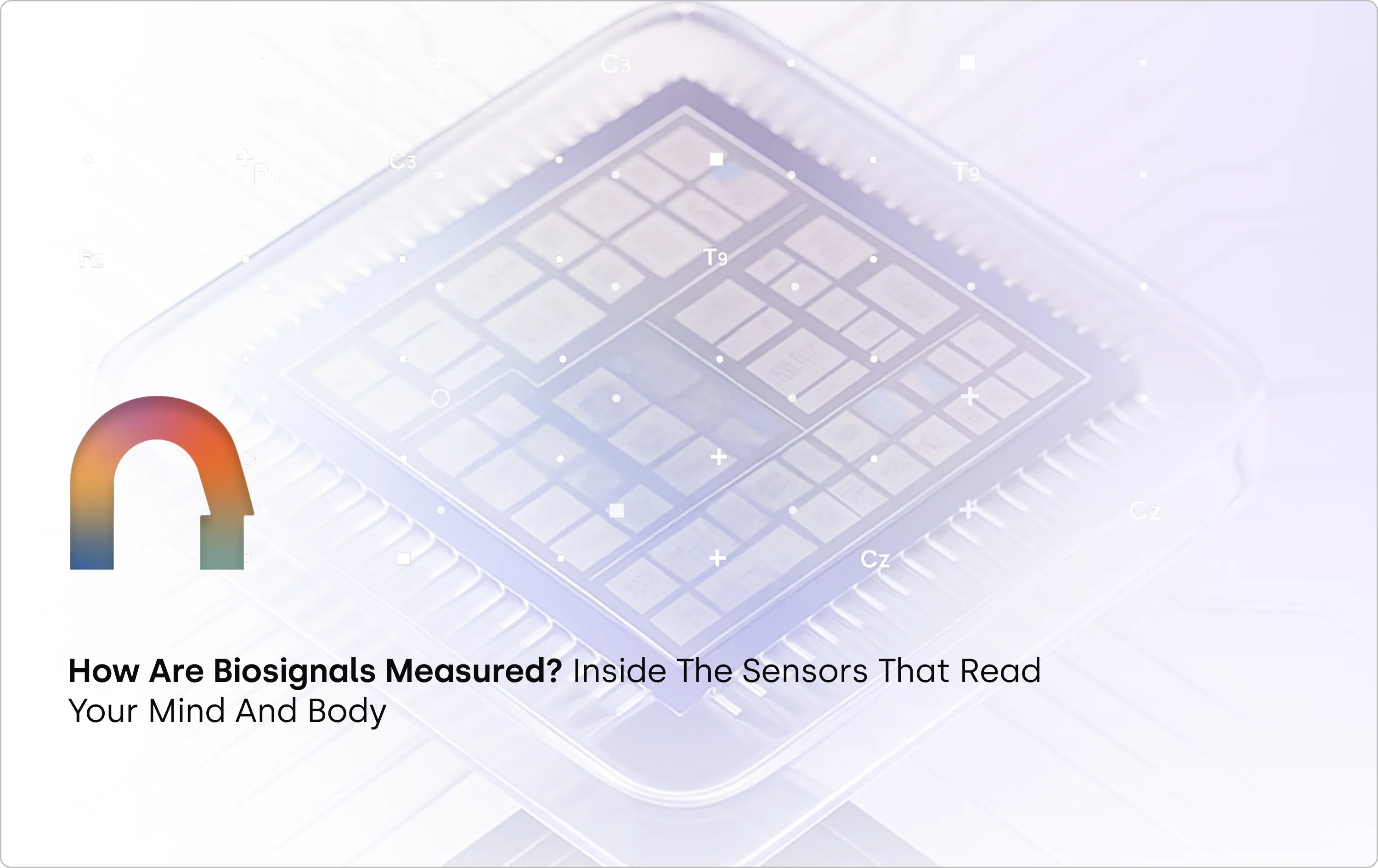
Every thought, heartbeat, and muscle twitch leaves behind a signal, but how do we actually capture them? In this blog post, we explore the sensors that make biosignal measurement possible, from EEG and ECG electrodes to optical and biochemical interfaces, and what it takes to turn those signals into meaningful data.
When we think of sensors, we often imagine cameras, microphones, or temperature gauges. But some of the most fascinating sensors aren’t designed to measure the world, they’re designed to measure you.
These are biosignal sensors: tiny, precise, and increasingly powerful tools that decode the electrical whispers of your brain, heart, and muscles. They're the hidden layer enabling brain-computer interfaces, wearables, neurofeedback systems, and next-gen health diagnostics.
But how do they actually work? And what makes one sensor better than another?
Let’s break it down, from scalp to circuit board.
First, a Quick Recap: What Are Biosignals?
Biosignals are the body’s internal signals, electrical, optical, or chemical , that reflect brain activity, heart function, muscle movement, and more. If you’ve read our earlier post on biosignal types, you’ll know they’re the raw material for everything from brain-computer interfaces to biometric wearables.
In this blog, we shift focus to the devices and sensors that make it possible to detect these signals in the real world, and what it takes to do it well.
The Devices That Listen In: Biosignal Sensor Types
.webp)
A Closer Look: How These Sensors Work
1. EEG / ECG / EMG – Electrical Sensors
These measure voltage fluctuations at the skin surface, caused by underlying bioelectric activity.
It’s like trying to hear a whisper in a thunderstorm; brain and muscle signals are tiny, and will get buried under noise unless the electrodes make solid contact and the amplifier filters aggressively.
There are two key electrode types:
- Wet electrodes: Use conductive gel or Saline for better signal quality. Still the gold standard in labs.
- Dry electrodes: More practical for wearables but prone to motion artifacts and noise (due to higher electrode resistance).
Signal acquisition often involves differential recording and requires high common-mode rejection ratios (CMRR) to suppress environmental noise.
Fun Fact: Even blinking your eyes generates an EMG signal that can overwhelm EEG data. That’s why artifact rejection algorithms are critical in EEG-based systems.
2. Optical Sensors (PPG, fNIRS)
These use light to infer blood flow or oxygenation levels:
- PPG: Emits light into the skin and measures reflection, pulsatile blood flow alters absorption.
- fNIRS: Uses near-infrared light to differentiate oxygenated vs. deoxygenated hemoglobin in the cortex.
Example: Emerging wearable fNIRS systems like Kernel Flow and OpenBCI Galea are making brain oxygenation measurement accessible outside labs.
3. Galvanic Skin Response / EDA – Emotion’s Electrical Signature
GSR (also called electrodermal activity) sensors detect subtle changes in skin conductance caused by sweat gland activity, a direct output of sympathetic nervous system arousal. When you're stressed or emotionally engaged, your skin becomes more conductive, and GSR sensors pick that up.
These sensors apply a small voltage across two points on the skin and track resistance over time. They're widely used in emotion tracking, stress monitoring, and psychological research due to their simplicity and responsiveness.
Together, these sensors form the foundation of modern biosignal acquisition — but capturing clean signals isn’t just about what you use, it’s about how you use it.
How Signal Quality Is Preserved
Measurement is just step one; capturing clean, interpretable signals involves:
- Analog Front End (AFE): Amplifies low signals while rejecting noise.
- ADC: Converts continuous analog signals into digital data.
- Signal Conditioning: Filters out drift, DC offset, 50/60Hz noise.
- Artifact Removal: Eye blinks, jaw clenches, muscle twitches.
Hardware platforms like TI’s ADS1299 and Analog Devices’ MAX30003 are commonly used in EEG and ECG acquisition systems.
New Frontiers in Biosignal Measurement
- Textile Sensors: Smart clothing with embedded electrodes for long-term monitoring.
- Biochemical Sensors: Detect metabolites like lactate, glucose, or cortisol in sweat or saliva.
- Multimodal Systems: Combining EEG + EMG + IMU + PPG in unified setups to boost accuracy.
A recent study involving transradial amputees demonstrated that combining EEG and EMG signals via a transfer learning model increased classification accuracy by 2.5–4.3% compared to EEG-only models.
Other multimodal fusion approaches, such as combining EMG and force myography (FMG), have shown classification improvements of over 10% compared to EMG alone.
Why Should You Care?
Because how we measure determines what we understand, and what we can build.
Whether it's a mental wellness wearable, a prosthetic limb that responds to thought, or a personalized neurofeedback app, it all begins with signal integrity. Bad data means bad decisions. Good signals? They unlock new frontiers.
Final Thought
We’re entering an era where technology doesn’t just respond to clicks, it responds to cognition, physiology, and intent.
Biosignal sensors are the bridge. Understanding them isn’t just for engineers; it’s essential for anyone shaping the future of human-aware tech.

In our previous blog, we explored how biosignals serve as the body's internal language—electrical, mechanical, and chemical messages that allow us to understand and interface with our physiology. Among these, electrical biosignals are particularly important for understanding how our nervous system, muscles, and heart function in real time. In this article, we’ll take a closer look at three of the most widely used electrical biosignals—EEG, ECG, and EMG—and their growing role in neurotechnology, diagnostics, performance tracking, and human-computer interaction. If you're new to the concept of biosignals, you might want to check out our introductory blog for a foundational overview.
"The body is a machine, and we must understand its currents if we are to understand its functions."-Émil du Bois-Reymond, pioneer in electrophysiology.
Life, though rare in the universe, leaves behind unmistakable footprints—biosignals. These signals not only confirm the presence of life but also narrate what a living being is doing, feeling, or thinking. As technology advances, we are learning to listen to these whispers of biology. Whether it’s improving health, enhancing performance, or building Brain-Computer Interfaces (BCIs), understanding biosignals is key.
Among the most studied biosignals are:
- Electroencephalogram (EEG) – from the brain
- Electrocardiogram (ECG) – from the heart
- Electromyogram (EMG) – from muscles
- Galvanic Skin Response (GSR) – from skin conductance
These signals are foundational for biosignal processing, real-time monitoring, and interfacing the human body with machines. In this article we look at some of these biosignals and some fascinating stories behind them.
Electroencephalography (EEG): Listening to Brainwaves
In 1893, a 19 year old Hans Berger fell from a horse and had a near death experience. Little did he know that it would be a pivotal moment in the history of neurotechnology. The same day he received a telegram from his sister who was extremely concerned for him because she had a bad feeling. Hans Berger was convinced that this was due to the phenomenon of telepathy. After all, it was the age of radio waves, so why can’t there be “brain waves”? In his ensuing 30 year career telepathy was not established but in his pursuit, Berger became the first person to record brain waves.
When neurons fire together, they generate tiny electrical currents. These can be recorded using electrodes placed on the scalp (EEG), inside the skull (intracranial EEG), or directly on the brain (ElectroCorticogram). EEG signal processing is used not only to understand the brain’s rhythms but also in EEG-based BCI systems, allowing communication and control for people with paralysis. Event-Related Potentials (ERPs) and Local Field Potentials (LFPs) are specialized types of EEG signals that provide insights into how the brain responds to specific stimuli.
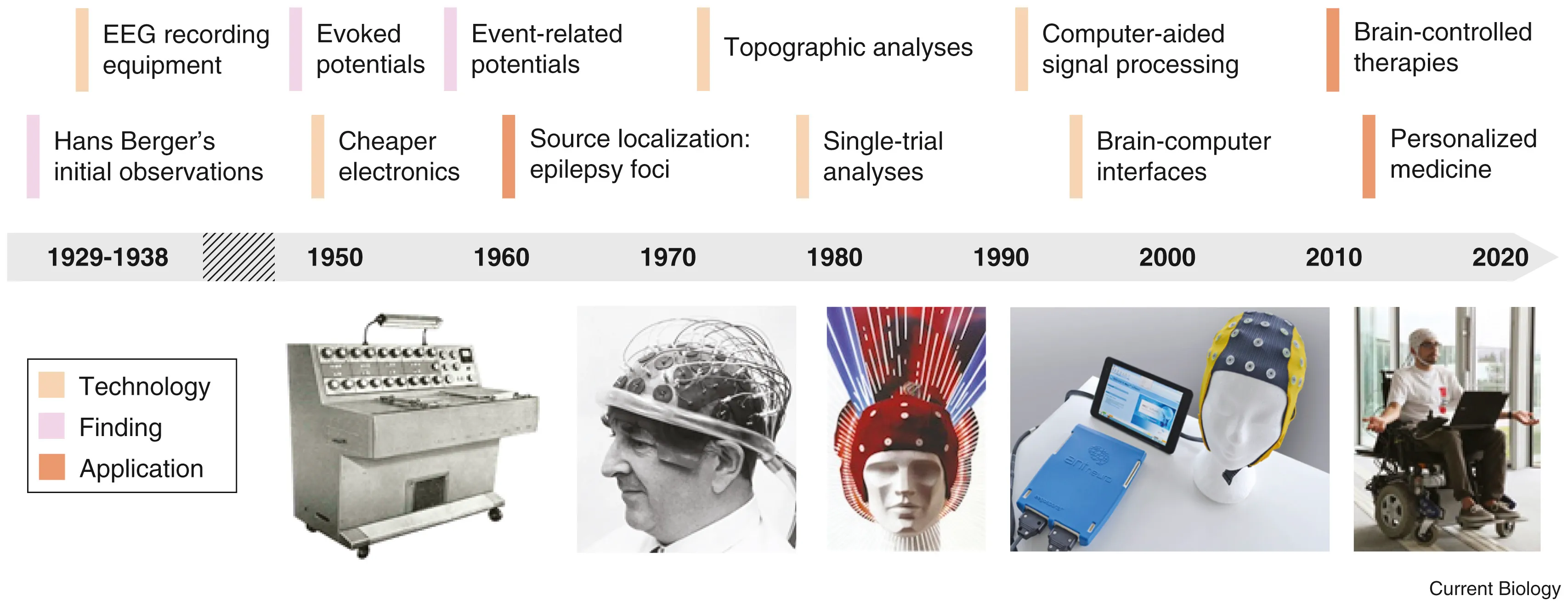
Electrocardiogram (ECG): The Rhythm of the Heart
The heart has its own internal clock which produces tiny electrical signals every time it beats. Each heartbeat starts with a small electrical impulse made by a special part of the heart called the sinoatrial (SA) node. This impulse spreads through the heart muscle and makes it contract, first the upper (atria) and then lower chambers (ventricles) – that’s what pumps blood. This process produces voltage changes, which can be recorded via electrodes on the skin.
This gives rise to the classic PQRST waveform, with each component representing a specific part of the heart’s cycle. Modern wearables and medical devices use ECG signal analysis to monitor heart health in real time.
Fun fact: The waveform starts with “P” because Willem Einthoven left room for earlier letters—just in case future scientists discovered pre-P waves! So, thanks to a cautious scientist, we have the quirky naming system we still follow today.
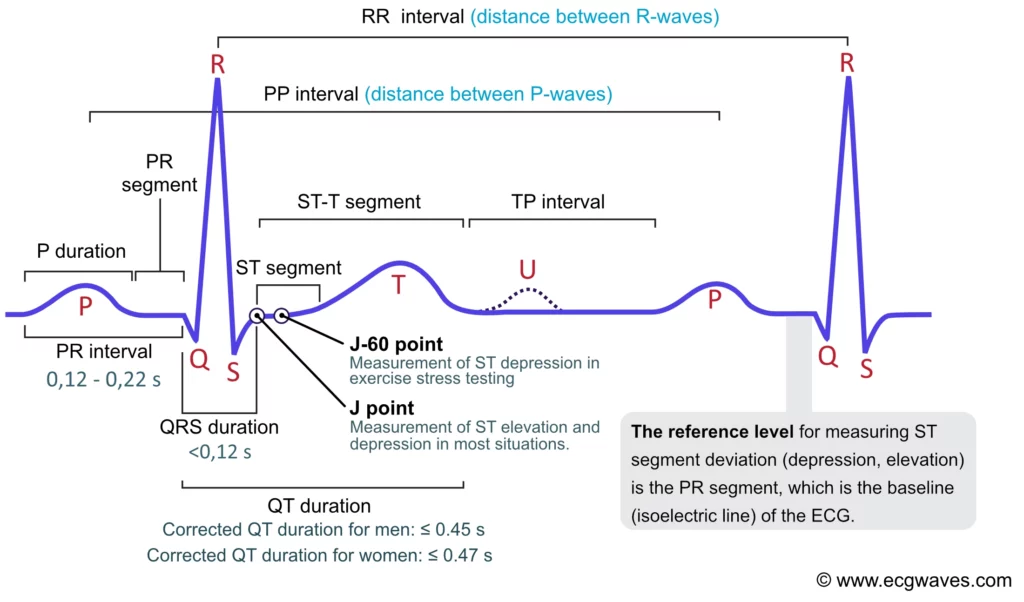
Electromyography (EMG): The Language of Movement
When we perform any kind of movement - lifting our arm, kicking our leg, smiling, blinking or even breathing- our brain sends electrical signals to our muscles telling them to contract. When these neurons, known as motor neurons fire they release electrical impulses that travel to the muscle, causing it to contract. This electrical impulse—called a motor unit action potential (MUAP)—is what we see as an EMG signal. So, every time we move, we are generating an EMG signal!
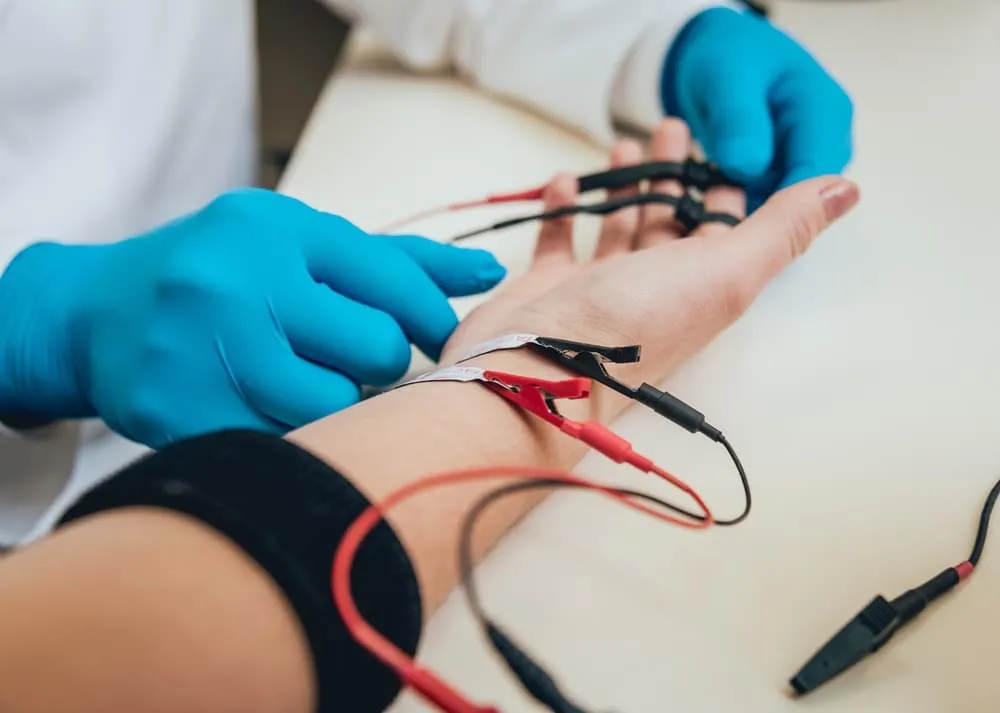
Medical Applications
Medically, EMG is used for monitoring muscle fatigue especially in rehabilitation settings and muscle recovery post-injury or surgery. This helps clinicians measure progress and optimize therapy. EMG can distinguish between voluntary and involuntary movements, making it useful in diagnosing neuromuscular disorders, assessing stroke recovery, spinal cord injuries, and motor control dysfunctions.
Performance and Sports Science
In sports science, EMG can tell us muscle-activation timing and quantify force output of muscle groups. These are important factors to measure performance improvement in any sport. The number of motor units recruited and the synergy between muscle groups, helps us capture “mind-muscle connection” and muscle memory. Such things which were previously spoken off in a figurative manner can be scientifically measured and quantified using EMG. By tracking these parameters we get a window into movement efficiency and athletic performance. EMG is also used for biofeedback training, enabling individuals to consciously correct poor movement habits or retrain specific muscles
Beyond medicine and sports, EMG is used for gesture recognition in AR/VR and gaming, silent speech detection via facial EMG, and next-gen prosthetics and wearable exosuits that respond to the user’s muscle signals. EMG can be used in brain-computer interfaces (BCIs), helping paralyzed individuals control digital devices or communicate through subtle muscle activity. EMG bridges the gap between physiology, behavior, and technology—making it a critical tool in healthcare, performance optimization, and human-machine interaction.
As biosignal processing becomes more refined and neurotech devices more accessible, we are moving toward a world where our body speaks—and machines understand. Whether it’s detecting the subtlest brainwaves, tracking a racing heart, or interpreting muscle commands, biosignals are becoming the foundation of the next digital revolution. One where technology doesn’t just respond, but understands.

